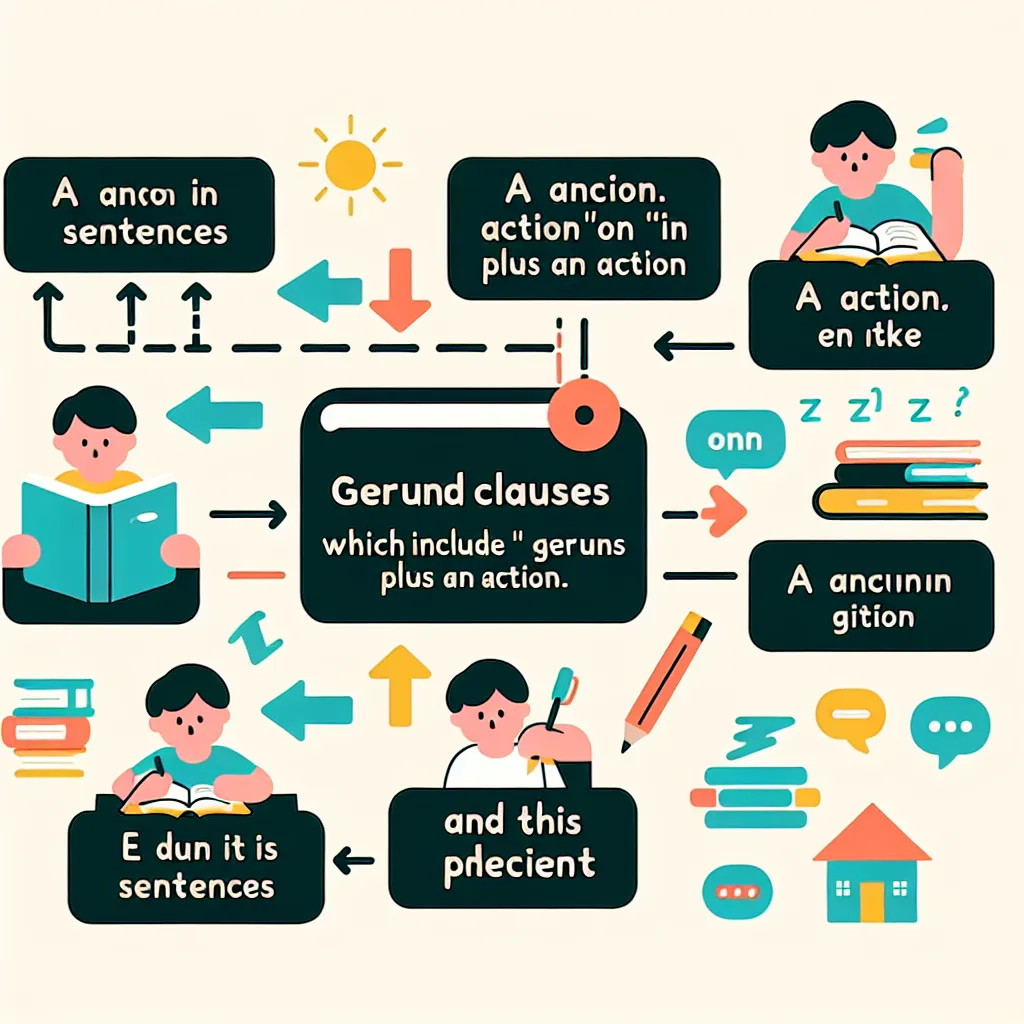Gerund clauses with “on” followed by an action are a powerful grammatical structure that can significantly enhance your IELTS score. This construction is frequently used in both the Writing and Speaking sections of the test, allowing candidates to express complex ideas concisely and elegantly. Let’s delve into the intricacies of this structure and explore how to use it effectively in your IELTS preparation.
Understanding Gerund Clauses with “On” + Action
Gerund clauses with “on” + action are used to describe an action that occurs immediately after or as a result of another action. This structure is particularly useful for expressing cause and effect relationships or sequential actions in a concise manner.

Formula and Grammar Rules
The basic formula for this structure is:
On + [verb]-ing, [subject] + [verb]
It’s important to note that the gerund (verb + -ing) always follows “on” directly, and the main clause follows the gerund clause. Let’s break down some examples to better understand this structure:
-
On arriving at the airport, we realized we had forgotten our passports.
- Gerund clause: “On arriving at the airport”
- Main clause: “we realized we had forgotten our passports”
-
On hearing the news, she burst into tears.
- Gerund clause: “On hearing the news”
- Main clause: “she burst into tears”
-
On completing the project, the team celebrated their success.
- Gerund clause: “On completing the project”
- Main clause: “the team celebrated their success”
Applying Gerund Clauses with “On” + Action in IELTS
IELTS Writing Task 2
In IELTS Writing Task 2, using gerund clauses with “on” + action can help you construct more sophisticated sentences and demonstrate a higher level of grammatical control. Here’s an example of how you might incorporate this structure into an essay:
Topic: The impact of technology on education
“On introducing digital learning platforms, many schools have seen a significant improvement in student engagement and performance. However, on analyzing the long-term effects, researchers have found that excessive screen time can lead to reduced social interaction among students. On realizing this potential drawback, educators are now seeking a balance between traditional and digital teaching methods.”
In this paragraph, we’ve used the structure three times to create a flowing, cohesive argument. Notice how each gerund clause introduces a new idea or consequence, helping to structure the paragraph logically.
IELTS Speaking Part 2
For the IELTS Speaking Part 2, where you’re asked to speak on a given topic for 1-2 minutes, incorporating gerund clauses with “on” + action can make your response more articulate and impressive. Here’s an example:
Topic: Describe a time when you received good news
“I’d like to talk about a time when I received some fantastic news about my university application. On checking my emails one morning, I saw a message from my dream university. On opening the email, I was overjoyed to find out that I had been accepted into their prestigious engineering program. On realizing what this meant for my future, I immediately called my parents to share the exciting news. On hearing my voice, they could tell something wonderful had happened, and we all celebrated together.”
By using this structure multiple times, the speaker demonstrates a high level of grammatical control and creates a narrative that flows naturally from one event to the next.
Advanced Usage for Higher Band Scores
To achieve higher band scores (7+) in IELTS, it’s crucial to use complex grammatical structures accurately and appropriately. Here are some advanced tips for using gerund clauses with “on” + action:
-
Combine with other complex structures:
“On arriving at the conference, which was attended by leading experts in the field, I realized the importance of networking for career development.” -
Use in conditional sentences:
“On completing the course, if students pass the final exam, they will be awarded an internationally recognized certificate.” -
Incorporate advanced vocabulary:
“On scrutinizing the data, the researchers discerned a pattern that had previously eluded them.” -
Use in passive constructions:
“On being informed of the changes, employees were asked to adapt their working methods accordingly.” -
Employ with modal verbs:
“On finishing the project, the team should conduct a thorough review to identify areas for improvement.”
Common Mistakes to Avoid
When using gerund clauses with “on” + action, be aware of these common errors:
-
Incorrect verb form after “on”:
- Incorrect: “On arrive at the station…”
- Correct: “On arriving at the station…”
-
Using a subject immediately after “on”:
- Incorrect: “On we arriving at the party…”
- Correct: “On arriving at the party, we…”
-
Forgetting the comma after the gerund clause:
- Incorrect: “On entering the room he noticed the strange atmosphere.”
- Correct: “On entering the room, he noticed the strange atmosphere.”
-
Using “upon” instead of “on”:
While “upon” can be used in similar constructions, it’s less common and may sound overly formal in some contexts. Stick to “on” for IELTS unless you’re absolutely confident in your usage of “upon”. -
Overusing the structure:
While it’s important to demonstrate your ability to use complex structures, overusing any one structure can make your writing or speaking seem repetitive and unnatural. Aim for a balance of different grammatical structures.
Conclusion
Mastering gerund clauses with “on” + action can significantly enhance your performance in the IELTS test. This structure allows you to express complex ideas concisely and elegantly, demonstrating a high level of grammatical control. Remember to practice using this structure in various contexts, combining it with other complex grammatical forms, and avoiding common mistakes. With consistent practice, you’ll be able to incorporate this structure naturally into your IELTS Writing and Speaking responses, potentially boosting your overall band score.
To further improve your skills, try creating your own sentences using this structure, focusing on topics commonly found in IELTS tests such as education, technology, environment, and social issues. The more you practice, the more confident and proficient you’ll become in using this sophisticated grammatical structure.